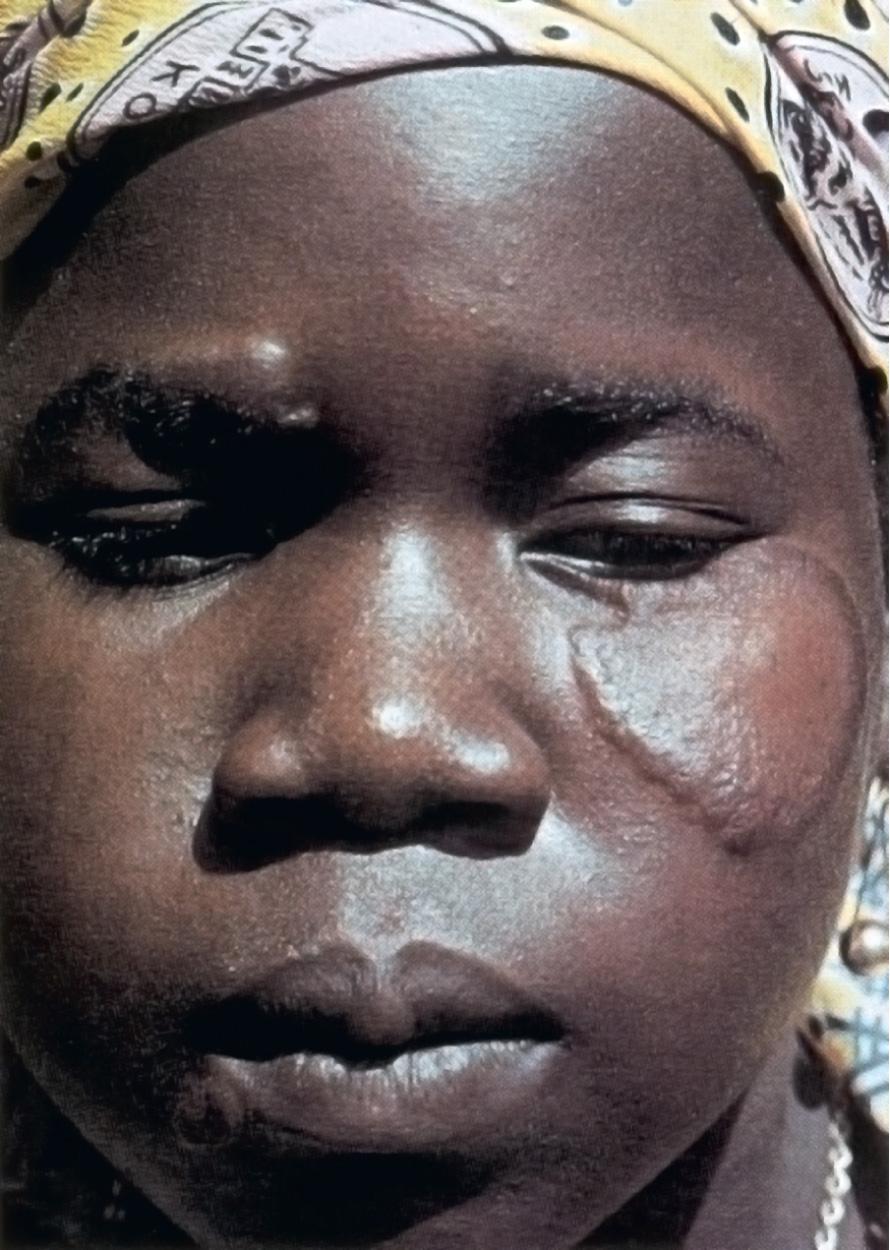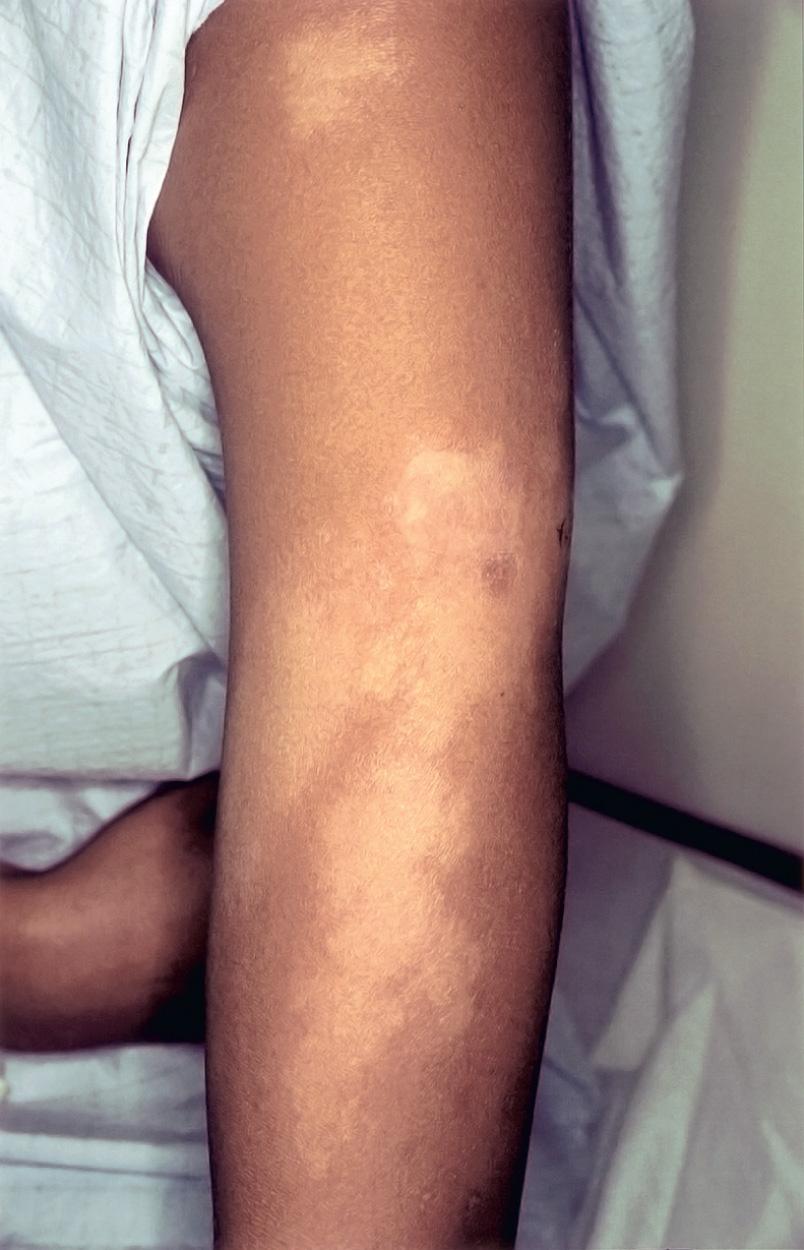Physical Address
304 North Cardinal St.
Dorchester Center, MA 02124
Leprosy (Hansen disease) is a heterogeneous, curable infection caused by Mycobacterium leprae that primarily affects the upper airway, skin, and peripheral nerves. Disease manifestations are mainly determined by the host's immunologic response to infection, resulting in a wide clinical spectrum. The majority of exposed individuals never develop clinical disease. Hansen disease ( HD ) is currently the accepted designation of leprosy, and contrary to popular folklore, HD is not highly transmissible and is treatable. In addition, the associated morbidity and disability can be prevented with early diagnosis and appropriate treatment.
Mycobacterium leprae is an obligate intracellular acid-fast gram-positive bacillus of the family Mycobacteriaceae measuring 1-8 µm in length. It grows optimally at 27-33°C (80.6-91.4°F) yet cannot be cultured in vitro. The bacillus multiplies slowly, with a doubling time of 11-13 days. It is the only bacterium known to infect Schwann cells of peripheral nerves. Identification of acid-fast bacilli in peripheral nerves is pathognomonic of leprosy.
The prevalence of leprosy is variable, with the majority of cases being identified in tropical and subtropical areas. The World Health Organization (WHO) goal to eliminate leprosy as a public health problem, defined as a reduction in its prevalence to less than 1 case per 10,000 population, was achieved at the global level in 2000. Despite an overall decline in reported prevalence, HD continues to afflict more than 2 million people worldwide. Approximately 213,899 new cases were reported globally in 2014, with >94% of cases occurring in Southeast Asia (mostly India), Africa, and South America (mostly Brazil). A total of 8.8% of these cases occurred in children. In 2016, WHO released Global Leprosy Strategy 2016–2020: Accelerating Towards a Leprosy-Free World .
Since 1984, HD has been a notifiable disease in the United States, with 13,950 registered cases by the end of 2015. Of the 178 new U.S. cases reported in 2015, 72% were identified in Texas, Louisiana, Hawaii, California, Florida, New York, and Arkansas. Of the U.S. cases, 57% were identified in immigrants, mainly Asian or South Pacific Islanders; however, over one third of U.S. cases are autochthonous and do not report contact with foreign countries or people with leprosy. Less than 3% of U.S. cases in 2015 occurred in children <16 yr old. Younger patients predominate in areas with high endemicity.
The likelihood of developing HD is determined by several variables: age (with 2 incidence peaks: 10-14 yr and 30 yr), gender (male/female ratio 2 : 1, with no differences observed in children), genetics, immune status, type of leprosy (with higher risk in those exposed to patients with multibacillary disease), and possibly through exposure to armadillos . Whole genome sequencing has allowed identification of genes and polymorphisms associated with increased susceptibility to leprosy (approximately 5% of people are genetically susceptible to M. leprae infection). HD in immunocompromised hosts has been reported in solid-organ and bone marrow transplant recipients and patients receiving tumor necrosis factor (TNF)–blocking monoclonal antibodies. Patients with HIV infection do not appear to be at increased risk of acquiring leprosy, increased disease severity, or poor response to treatment. However, clinicians should be aware that concomitant HIV infection and leprosy can result in worsening of symptoms of leprosy during HIV treatment as a result of an immune reconstitution inflammatory syndrome.
The exact mechanism of transmission is not fully understood but is thought to occur primarily by the respiratory route. Natural infection occurs in humans and armadillos, which are the only recognized nonhuman reservoir. The risk of transmission from armadillos to humans seems low, and again the mechanism is not fully understood. The incubation period between natural infection and overt clinical disease in humans ranges from 3 mo to 20 yr, with a mean of 4 yr for tuberculoid leprosy and 10 yr for lepromatous leprosy. Up to 10 7 viable bacilli per day can be shed in the respiratory secretions of patients with multibacillary leprosy. The relative risk for developing disease in household contacts is 8-10 fold for lepromatous disease and 2-4–fold for the tuberculoid form. Transmissions by breast milk, the transplacental route, and through broken skin have been reported. Environmental factors and subclinically infected humans may also play a role in disease transmission. The infectivity of patients with HD becomes negligible within 24 hr of the first administration of effective therapy.
In the skin, M. leprae shows affinity for keratinocytes, macrophages, and histiocytes, and in peripheral nerves the organism can be found in the Schwann cells. The mechanism of mycobacterial dissemination from the respiratory tract to the skin and nerves is thought to occur hematogenously but has not been completely elucidated. M. leprae induces demyelination and binds to the laminin-2 glycoprotein present in the basal lamina of Schwann cells in peripheral nerves, where it replicates slowly over several years. Infection stimulates the dedifferentiation of Schwann cells to immature cells through the activation of the Erk1/2 pathway. This reprogramming of Schwann cells seems to be linked to disease dissemination. In addition to the direct nerve invasion, the immune response to infection also contributes to nerve damage. Schwann cells express human leukocyte antigen (HLA) class II molecules and present mycobacterial peptides to the HLA class II–restricted CD4 + T cells, which initiate an inflammatory response. These events explain the nerve damage seen in paucibacillary disease and in reversal reactions. Swelling within the perineurium leads to ischemia, further nerve damage, and eventually fibrosis and axonal death.
Disease classification is important to determine potentially infectious cases and prognosis. Based on the cellular immune response and disease dissemination, 2 classification schemes for leprosy are frequently used: the Ridley-Jopling scale and the WHO classification:
The Ridley-Jopling scale is used in the United States and describes the 5 types of leprosy, according to clinical spectrum of disease, bacillary load, and findings on histopathology.
Tuberculoid form : Patients usually have a vigorous and specific cellular immune response to M. leprae antigens and have a small number of skin lesions, generally, 1-3 well-demarcated macules or plaques with elevated borders ( Fig. 243.1 ) and reduced or absent sensation. The lesions are infiltrated by T-helper 1 (Th1) cells producing abundant interferon (IFN)-γ and TNF-α, forming well-demarcated granulomas, with few, if any bacilli found within the lesions.

Borderline tuberculoid form
Borderline form
Borderline lepromatous
Lepromatous form : Patients have an absence of specific cellular immunity to M. leprae (but intact immunity to Mycobacterium tuberculosis ) and present the most severe form of disease. They manifest clinically apparent infiltration of peripheral nerves and skin lesions (usually many lesions and not all hypoesthetic or anesthetic), with a high load of bacilli in the absence of an effective cell-mediated immune response. Skin biopsies reveal extensive infiltration of the skin and nerves, containing messenger RNA for Th2 cytokines such as interleukin (IL)-4 and IL-10, poorly formed granulomas, and uncontrolled proliferation of bacilli within foamy macrophages. A large amount of circulating antibody to M. leprae is present but does not confer protective immunity. Over time, patients with the lepromatous form develop a systemic disease with symmetric peripheral nerve involvement and a diffuse infiltrative dermopathy that includes thickening of the facial skin and hair loss of the eyelashes and eyebrows (madarosis), leading to the classic presentation of the leonine facies . They also have involvement of the nasal mucosa causing nasal congestion and epistaxis.
The majority of patients will present with a borderline form. From borderline tuberculoid to borderline lepromatous forms, there is a progressive reduction in cellular immune responses, an increase in bacillary load, more frequent hypopigmented skin lesions and nerve involvement, and higher antibody titers ( Fig. 243.2 ). Patients with the extreme forms of the disease (tuberculoid and lepromatous) are considered to have stable cell-mediated immunity, because their disease manifestations do not change much over time. In contrast, patients with borderline disease have unstable cell-mediated immunity and demonstrate changes in their clinical manifestations over time toward the polar forms (downgrade) or present sudden reversal reactions (upgrade). Indeterminate leprosy is the earliest form of the disease and is seen most frequently in young children. Patients usually have a single hypopigmented macule with poorly defined borders, without erythema or induration. Anesthesia is minimal or absent, especially if the lesion is on the face. The diagnosis is usually one of exclusion in the setting of a contact investigation. Tissue biopsies show diagnostic evidence of leprosy but do not meet sufficient criteria for classification. Up to 50–75% of these lesions will heal spontaneously, and the rest will progress to another form of leprosy.

The WHO classification can be used when histologic evaluation and confirmatory diagnosis is unavailable, a common scenario in the field. This simplified scheme is based on the number of skin lesions:
Paucibacillary (1-5 patches)
Multibacillary (>5 patches)
Become a Clinical Tree membership for Full access and enjoy Unlimited articles
If you are a member. Log in here